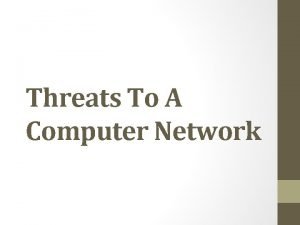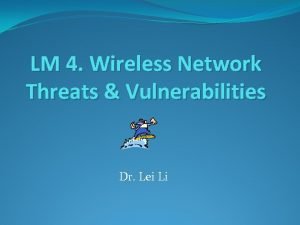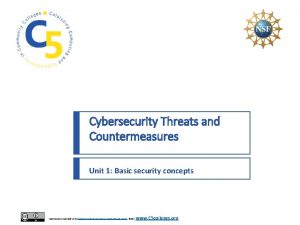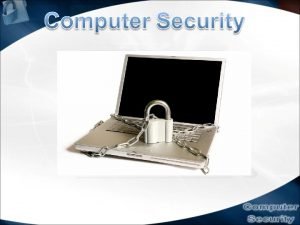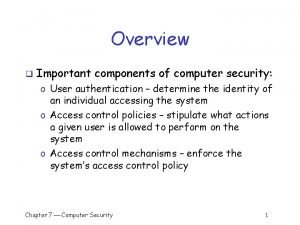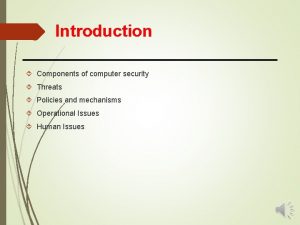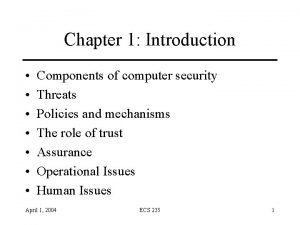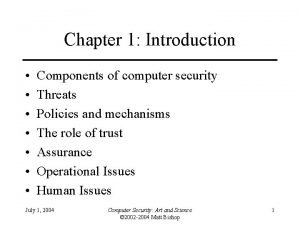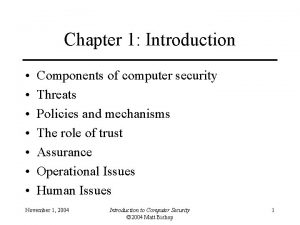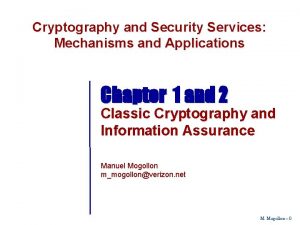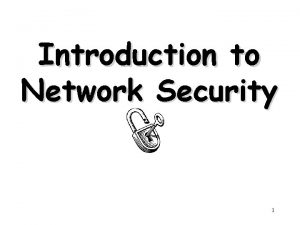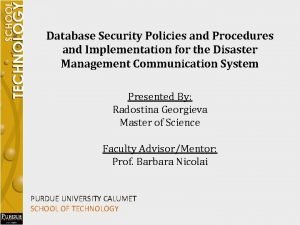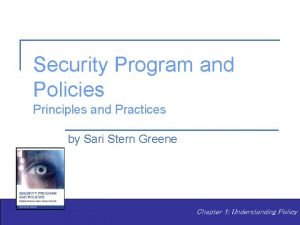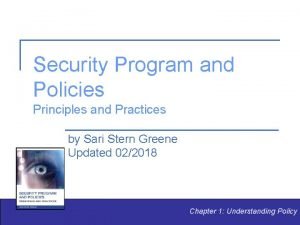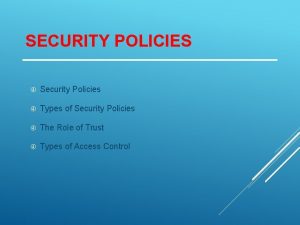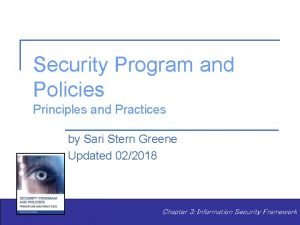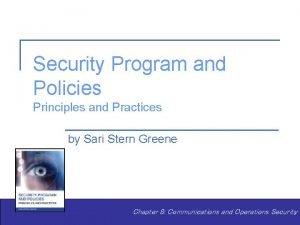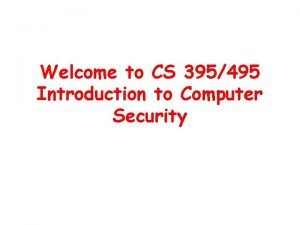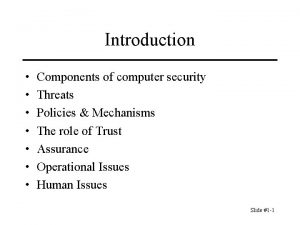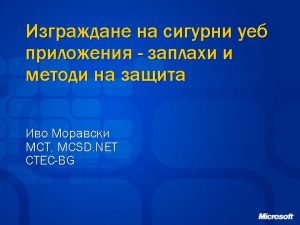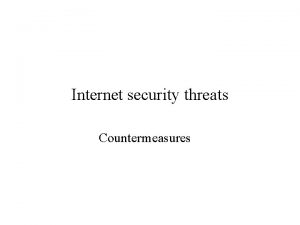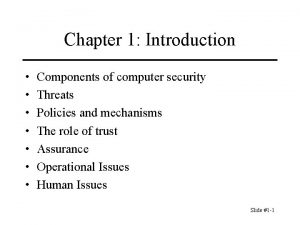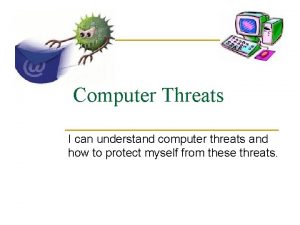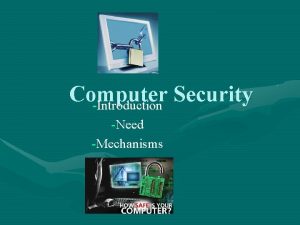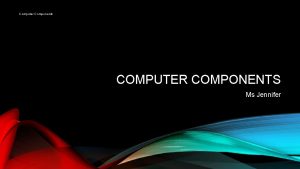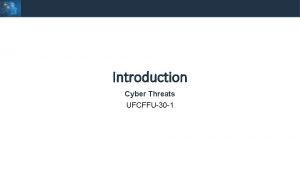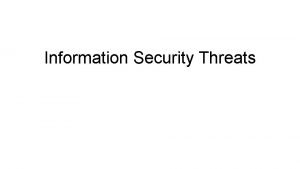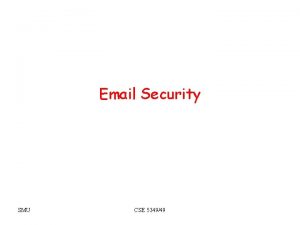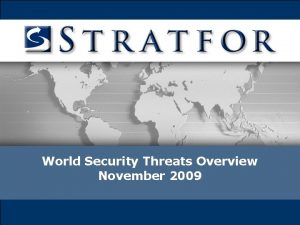Introduction Components of computer security Threats Policies Mechanisms




























- Slides: 28

Introduction • • Components of computer security Threats Policies & Mechanisms The role of Trust Assurance Operational Issues Human Issues Slide #1 -1

Basic Components (C-I-A Triad) • Confidentiality • Integrity • Availability • Sometimes two other desirable characteristics: • Authentication • Nonrepudiation Slide #1 -2

Confidentiality Keeping data and resources hidden • Need-to-know principle • Illicit/unlawful access to information • Tools: cryptography – Encrypting data with a cryptographic key will assure privacy: only those with the decryption key can access the contents. • Resource hiding • Access control mechanisms support privacy Slide #1 -3

Integrity • Data integrity (integrity) – The data is authentic, i. e. , has not been tampered/corrupted • Origin integrity (authentication) – The source of the information is authentic • Integrity mechanisms fall into two classes: – Prevention mechanisms (block unauthorized attempts) – Detection mechanisms (analyze system events and report integrity failures) Slide #1 -4

Availability Enable/Ensure access to data and resources • Reliability • Denial of Service attacks (Do. S) • Can be the most difficult to detect because the analyst must determine if an unusual access pattern is attributable to deliberate manipulation of resources or of the environment (failure in the reliability). Slide #1 -5

Relationship between Confidentiality Integrity and Availability Confidentiality Secure Integrity Availability Slide #1 -6

7 Basic Terms • Threat • Attack • Vulnerability • Countermeasure or control From Security in Computing, Fifth Edition, by Charles P. Pfleeger, et al. (ISBN: 9780134085043). Copyright 2015 by Pearson Education, Inc. All rights reserved.

8 Access Control From Security in Computing, Fifth Edition, by Charles P. Pfleeger, et al. (ISBN: 9780134085043). Copyright 2015 by Pearson Education, Inc. All rights reserved.

9 Types of Threats From Security in Computing, Fifth Edition, by Charles P. Pfleeger, et al. (ISBN: 9780134085043). Copyright 2015 by Pearson Education, Inc. All rights reserved.

10 Advanced Persistent Threat (APT) • Organized • Directed • Well financed • Patient • Silent From Security in Computing, Fifth Edition, by Charles P. Pfleeger, et al. (ISBN: 9780134085043). Copyright 2015 by Pearson Education, Inc. All rights reserved.

11 Types of Attackers From Security in Computing, Fifth Edition, by Charles P. Pfleeger, et al. (ISBN: 9780134085043). Copyright 2015 by Pearson Education, Inc. All rights reserved.

12 Types of Harm From Security in Computing, Fifth Edition, by Charles P. Pfleeger, et al. (ISBN: 9780134085043). Copyright 2015 by Pearson Education, Inc. All rights reserved.

Threats • A threat is a potential violation of security. • The violation need not occur for there to be a threat. • The fact that the violation might occur means that the actions that might cause it should be guarded against. • The three security services discussed earlier (CIA) counter/prevent threats to the security of the system. Slide #1 -13

Vulnerabilities, Threats, Attacks, Controls • Vulnerability is a weakness in the security system – (i. e. , in procedures, design, or implementation), that might be exploited to cause loss or harm. • A threat to a computing system is a set of circumstances that has the potential to cause loss or harm. • A human who exploits a vulnerability perpetrates (carry out or commit a harmful, illegal, or immoral action) an attack on the system. • How do we address these problems? – We use a control as a protective measure. • That is, a control is an action, device, procedure, or technique that removes or reduces a vulnerability.

Classes of Threats • Disclosure – Snooping (spying) / interception • Deception – Modification, spoofing, repudiation of origin, denial of receipt, fabrication • Disruption – Modification Slide #1 -15

Policies and Mechanisms (Countermeasure or control) • Policy defines what is, and what is not, allowed – This defines “security” for the site/system/etc. – May be expressed in • Natural Language, which is usually imprecise but easy to understand • Mathematics, which is usually precise but hard to understand • Policy Languages, which look like some form of programming language and try to balance precision with ease of understanding Slide #1 -16

Policies and Mechanisms • Mechanisms enforce policies – Mechanism = a method, tool or procedure – Mechanisms may be • Technical, in which controls in the computer system enforce the policy: – i. e. , the requirement that a user supply a password to authenticate herself before using the computer • Procedural, in which controls outside the system enforce the policy: – i. e. , firing someone for bringing in a disk containing a game program obtained from an untrusted source Slide #1 -17

Policies and Mechanisms • Composition of policies – If policies conflict, discrepancies/contradictions may create security vulnerabilities – The composition problem requires checking for inconsistencies among policies. – If, for example, one policy allows students and faculty access to all data, and the other allows only faculty access to all the data, then they must be resolved • (e. g. , partition the data so that students and faculty can access some data, and only faculty access the other data). Slide #1 -18

19 Controls/Countermeasures From Security in Computing, Fifth Edition, by Charles P. Pfleeger, et al. (ISBN: 9780134085043). Copyright 2015 by Pearson Education, Inc. All rights reserved.

Goals of Security • Prevention – Prevent attackers from violating security policy • Detection – Detect attackers’ violation of security policy • Recovery – Stop attack, assess and repair damage – Continue to function correctly even if attack succeeds Slide #1 -20

Security Goals • When we talk about computer security, we mean that we are addressing three important aspects of any computer-related system: confidentiality, integrity, and availability (CIA) – Confidentiality ensures that computer-related assets are accessed only by authorized parties. • Reading, viewing, printing, or even knowing their existence • Secrecy or privacy – Integrity means that assets can be modified only by authorized parties or only in authorized ways. • Writing, changing, deleting, creating – Availability means that assets are accessible to authorized parties at appropriate times. For this reason, availability is sometimes known by its opposite, denial of service.

Trust and Assumptions • Trust underlies all aspects of security • Policies – Unambiguously partition system states – Correctly capture security requirements • Mechanisms – Assumed to enforce policy – Support mechanisms work correctly Slide #1 -22

Types of Mechanisms • Let P be the set of all possible states. • Let Q be the set of secure states as specified by the security policy: Q P • Let the security mechanisms restrict the system to some set of states, R (thus R P) • The enforcement mechanism is – A security mechanism is Secure if R Q – It is Precise if R = Q – it is Broad if there is a state r such that r R and r Q. 23

Types of Mechanisms broad secure set R precise set Q (secure states) 24

Types of Mechanisms secure precise broad set of reachable states set of secure states (that the computer can enter) (as allowed by the security policy) Slide #1 -25

Human Issues • Organizational Problems – Power and responsibility • those responsible have the power to enforce it • i. e. system administrators are responsible for security, but only security officers can make the rules. • People problems – Outsiders and insiders • It is speculated that insiders account for 80 -90% of all security problems – Social engineering Slide #1 -26

Security Life Cycle Threats Policy Specification Design Implementation Operation and Maintenance

Key Points • Policy defines security, and mechanisms enforce security – Confidentiality – Integrity – Availability • Trust and knowing assumptions • The human factor Slide #1 -28
 Common computer threats
Common computer threats Wireless security threats and vulnerabilities
Wireless security threats and vulnerabilities Cyber security threats and countermeasures
Cyber security threats and countermeasures Ccna security chapter 1
Ccna security chapter 1 Ecommerce security threats
Ecommerce security threats Wireless security threats
Wireless security threats Private securty
Private securty Basic components of security
Basic components of security Hru
Hru Https://www.naturalnews.com wikipedia
Https://www.naturalnews.com wikipedia Components of computer security
Components of computer security Basic components of computer security
Basic components of computer security Components of computer security
Components of computer security Components of computer security
Components of computer security Components of computer security
Components of computer security Components of computer security
Components of computer security Introduction to cryptography and network security
Introduction to cryptography and network security Security services and mechanisms in cryptography
Security services and mechanisms in cryptography Security attacks services and mechanisms
Security attacks services and mechanisms Security program and policies principles and practices
Security program and policies principles and practices Database security policy
Database security policy Security program and policies principles and practices
Security program and policies principles and practices Security program and policies principles and practices
Security program and policies principles and practices Bell lapadula model
Bell lapadula model Security program and policies principles and practices
Security program and policies principles and practices Security program and policies principles and practices
Security program and policies principles and practices Introduction to computer security
Introduction to computer security Major threats to biodiversity
Major threats to biodiversity River animal adaptations
River animal adaptations
